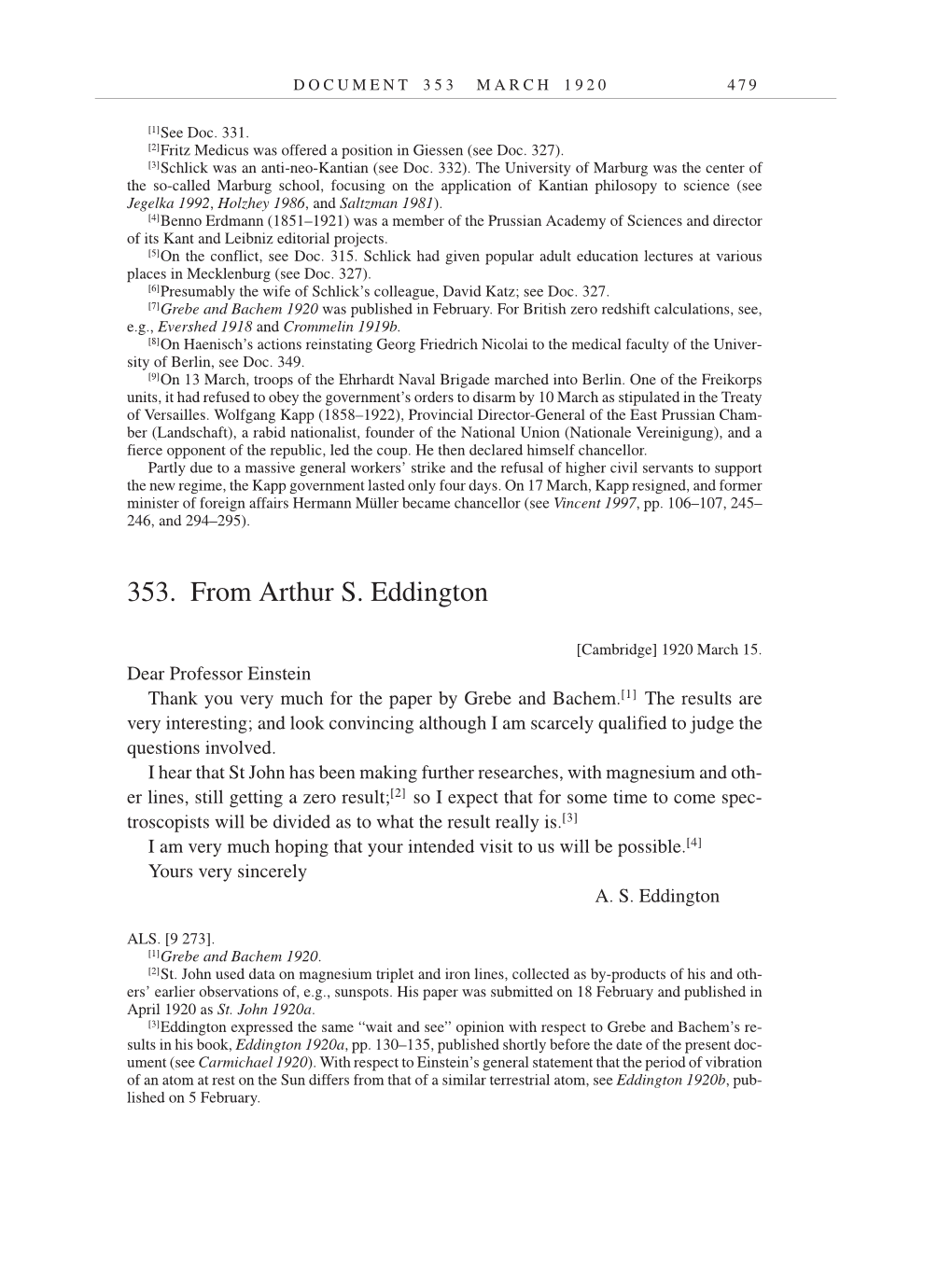D O C U M E N T 3 5 3 M A R C H 1 9 2 0 4 7 9
[1]See Doc. 331.
[2]Fritz Medicus was offered a position in Giessen (see Doc. 327).
[3]Schlick was an anti-neo-Kantian (see Doc. 332). The University of Marburg was the center of
the so-called Marburg school, focusing on the application of Kantian philosopy to science (see
Jegelka 1992, Holzhey 1986, and Saltzman 1981).
[4]Benno Erdmann (1851–1921) was a member of the Prussian Academy of Sciences and director
of its Kant and Leibniz editorial projects.
[5]On the conflict, see Doc. 315. Schlick had given popular adult education lectures at various
places in Mecklenburg (see Doc. 327).
[6]Presumably the wife of Schlick’s colleague, David Katz; see Doc. 327.
[7]Grebe and Bachem 1920 was published in February. For British zero redshift calculations, see,
e.g., Evershed 1918 and Crommelin 1919b.
[8]On Haenisch’s actions reinstating Georg Friedrich Nicolai to the medical faculty of the Univer-
sity of Berlin, see Doc. 349.
[9]On 13 March, troops of the Ehrhardt Naval Brigade marched into Berlin. One of the Freikorps
units, it had refused to obey the government’s orders to disarm by 10 March as stipulated in the Treaty
of Versailles. Wolfgang Kapp (1858–1922), Provincial Director-General of the East Prussian Cham-
ber (Landschaft), a rabid nationalist, founder of the National Union (Nationale Vereinigung), and a
fierce opponent of the republic, led the coup. He then declared himself chancellor.
Partly due to a massive general workers’ strike and the refusal of higher civil servants to support
the new regime, the Kapp government lasted only four days. On 17 March, Kapp resigned, and former
minister of foreign affairs Hermann Müller became chancellor (see Vincent 1997, pp. 106–107, 245–
246, and 294–295).
353. From Arthur S. Eddington
[Cambridge] 1920 March 15.
Dear Professor Einstein
Thank you very much for the paper by Grebe and
Bachem.[1]
The results are
very interesting; and look convincing although I am scarcely qualified to judge the
questions involved.
I hear that St John has been making further researches, with magnesium and oth-
er lines, still getting a zero
result;[2]
so I expect that for some time to come spec-
troscopists will be divided as to what the result really
is.[3]
I am very much hoping that your intended visit to us will be
possible.[4]
Yours very sincerely
A. S. Eddington
ALS. [9 273].
[1]Grebe and Bachem 1920.
[2]St. John used data on magnesium triplet and iron lines, collected as by-products of his and oth-
ers’ earlier observations of, e.g., sunspots. His paper was submitted on 18 February and published in
April 1920 as St. John 1920a.
[3]Eddington expressed the same “wait and see” opinion with respect to Grebe and Bachem’s re-
sults in his book, Eddington 1920a, pp. 130–135, published shortly before the date of the present doc-
ument (see Carmichael 1920). With respect to Einstein’s general statement that the period of vibration
of an atom at rest on the Sun differs from that of a similar terrestrial atom, see Eddington 1920b, pub-
lished on 5 February.
